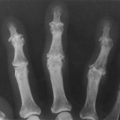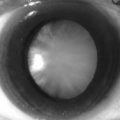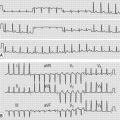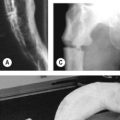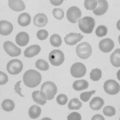149 Scleroderma
Salient features
Examination
• Thickening and tightening of the skin over fingers, sclerodactyly (finger pulp atrophy) (Fig. 149.1), beaking of nails (pseudoclubbing), atrophic nails, telangiectasia (nailfold capillaries) (Fig. 149.2)
• Raynaud’s phenomenon (see Fig. 161.1)
• Subcutaneous calcification (fingers, elbows and extensor aspect of the forearms)
Questions
What other organ systems are involved?
Skin. Raynaud’s phenomenon, localized morphea, local or generalized oedema, hyperpigmentation, telangiectasia, subcutaneous calcification, ulceration, particularly at the fingertips. Ten-year survival rate is 71% with skin tightness limited to fingers but 21% with diffuse truncal skin involvement. Ilioprost, a prostacyclin analogue, helps to heal digital ulceration. Penicillamine improves the skin and prolongs survival in patients with early, rapidly progressive, systemic sclerosis.
Musculoskeletal system. Arthritis, myositis, myopathy, bone ischaemia with resorption of the phalanges.
GI tract. Dysphagia, reflux oesophagitis, large or small bowel obstruction.
Lung. Fibrosis, atelectasis, pulmonary hypertension; pneumonia.
Kidney. Glomerulonephritis, malignant hypertension (poorest prognosis with renal involvement). ACE inhibitors dramatically improve renal crisis.
Advanced-level questions
What are the criteria for diagnosis of scleroderma?
What are the subsets of scleroderma?
• Limited cutaneous scleroderma: where the skin is affected only at the extremities
• Diffuse cutaneous scleroderma: skin of trunk and extremities affected
• Scleroderma sine scleroderma: skin not affected, patients present with pulmonary fibrosis, scleroderma renal crisis, cardiac failure or malabsorption and pseudo-obstruction. The presence of anti-centromere, scleroderma-70 and anti-nuclear antibodies can be helpful.
What do you know about the pathogenesis of these skin changes?
• Endothelial damage caused by a circulatory protein factor has been implicated as an early component of the ‘inflammatory’ phase; this endothelial damage may result in the capillary and arteriolar abnormalities seen as well as affecting local access of circulating proteins acting on fibroblast-enhancing collagen secretion.
• The profibrotic phenotype of fibroblasts in scleroderma is maintained by at least three factors:
How would you manage a patient with scleroderma?
• Educational and psychological support
• Treat vascular abnormalities such as Raynaud’s phenomenon
• Symptomatic treatment, e.g. omeprazole for oesophagitis
• Early phase of diffuse form: immunosuppressive drugs (cyclophosphamide, methotrexate, anti-thymocyte immunoglobulin)
• Later stages: antifibrotic drugs (penicillamine, interferon).
What is the role of prednisone in the treatment of scleroderma?
Prednisone has little or no role in the treatment of scleroderma.
What are the common fatal events in this disease?
In most cases, death results from cardiac, renal or respiratory failure.




